 Kia Forte: Seat belt restraint system
Kia Forte: Seat belt restraint system
Seat belts are designed to bear upon the bony structure of the body, and should be worn low across the pelvis, chest and shoulders as applicable. Wearing the lap section of the belt across the abdominal area must be avoided.
Seat belts should be adjusted as firmly as possible, consistent with comfort, to provide the protection for which they have been designed. A slack belt will greatly reduce the protection afforded to the wearer.
Care should be taken to avoid contamination of the webbing with polishes, oils and chemicals, and particularly battery acid. Cleaning may safely be carried out using mild soap and water. The belt should be replaced if webbing becomes frayed, contaminated or damaged.
- For maximum restraint system protection, the seat belts must always be used whenever the vehicle is moving. A properly positioned shoulder belt should be positioned midway over your shoulder across your collarbone.
- Never allow children to ride in the front passenger seat. See child restraint system section for further discussion.
WARNING - Shoulder belt
Never wear the shoulder belt under your arm or behind your back. An improperly positioned shoulder belt cannot protect the occupant in a crash.
WARNING - Damaged seat belt
Replace the entire seat belt assembly if any part of the webbing or hardware is damaged as you can no longer be sure that a damaged seat belt will provide protection in a crash.
WARNING - Twisted seat belt
Make sure your seat belt is not twisted when worn. A twisted seat belt may not properly protect you in an accident and could even cut into your body.
WARNING - Seat belt buckle
Do not allow foreign material (gum, crumbs, coins, etc.) to obstruct the seat belt buckle. This may prevent the seat belt from fastening securely.
Seat belt warning (for driverŌĆÖs seat)
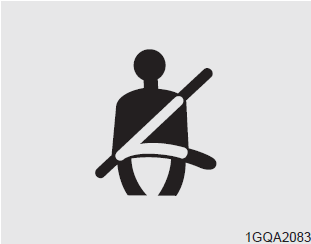
The driver's seat belt warning light and chime will activate to the following table when the ignition switch is in "ON" position.
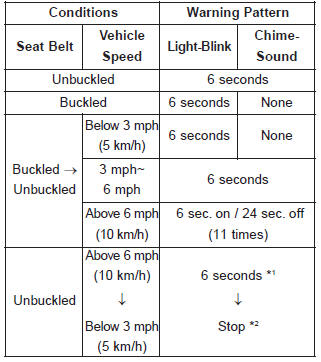
*1Warning pattern repeats 11 times with an interval of 24 seconds. If the driver's seat belt is buckled, the light will stop within 6 seconds and chime will stop immediately.
*2 The light will stop within 6 seconds and chime will stop immediately.
Seat belt - Driver's 3-point system with emergency locking retractor
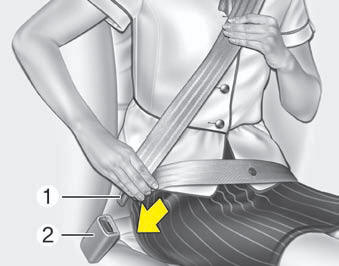
To fasten your seat belt:
To fasten your seat belt, pull it out of the retractor and insert the metal tab (1) into the buckle (2). There will be an audible "click" when the tab locks into the buckle.
The seat belt automatically adjusts to the proper length only after the lap belt portion is adjusted manually so that it fits snugly around your hips.
If you lean forward in a slow, easy motion, the belt will extend and let you move around. If there is a sudden stop or impact, however, the belt will lock into position. It will also lock if you try to lean forward too quickly.
If you are unable to pull out the seat belt from the retractor, firmly pull the belt out and release it. Then you will be able to pull the belt out smoothly.
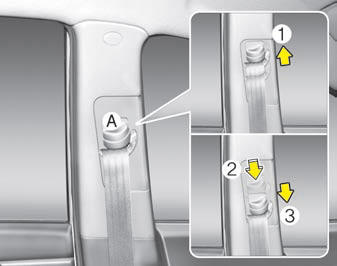
Height adjustment
You can adjust the height of the shoulder belt anchor to one of the 4 positions for maximum comfort and safety.
The height of the adjusting seat belt should not be too close to your neck.
The shoulder portion should be adjusted so that it lies across your chest and midway over your shoulder nearest the door and not your neck.
To adjust the height of the seat belt anchor, lower or raise the height adjuster into an appropriate position.
To raise the height adjuster, pull it up (1). To lower it, push it down (3) while pressing the height adjuster button (2).
Release the button to lock the anchor into position. Try sliding the height adjuster to make sure that it has locked into position.
WARNING - Shoulder belt positioning
Never position the shoulder belt across your neck or face.
WARNING - Seat belt replacement
Replace your seat belts after being in an accident. Failure to replace seat belts after an accident could leave you with damaged seat belts that will not provide protection in the event of another collision.
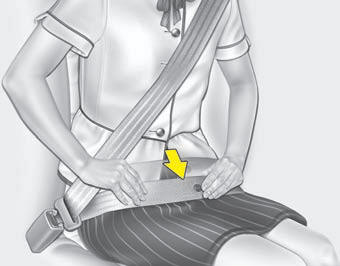
You should place the lap belt portion as low as possible and snugly across your hips. If the lap belt is located too high on your waist, it may increase the chance of injury in the event of a collision.
The arm closest to the seat belt buckle should be over the belt while the other arm should be under the belt as shown in the illustration.
Seat belts - Front passenger and rear seat 3-point system with combination locking retractor
To fasten your seat belt
Combination retractor type seat belts are installed in the rear seat positions to help accommodate the installation of child restraint systems.
Although a combination retractor is also installed in the front passenger seat position, it is strongly recommended that children always be seated in the rear seat. NEVER place an infant restraint system in the front seat of the vehicle.
This type of seat belt combines the features of both an emergency locking retractor seat belt and an automatic locking retractor seat belt.
To fasten your seat belt, pull it out of the retractor and insert the metal tab into the buckle. There will be an audible "click" when the tab locks into the buckle. When not securing a child restraint, the seat belt operates in the same way as the driver's seat belt (Emergency Locking Retractor Type).
It automatically adjusts to the proper length only after the lap belt portion of the seat belt is adjusted manually so that it fits snugly around your hips.
When the seat belt is fully extended from the retractor to allow the installation of a child restraint system, the seat belt operation changes to allow the belt to retract, but not to extend (Automatic Locking Retractor Type).
Refer to ŌĆ£Using a child restraint systemŌĆØ in this section.
To convert from the automatic locking feature to the emergency locking operation mode, allow the unbuckled seat belt to fully retract.
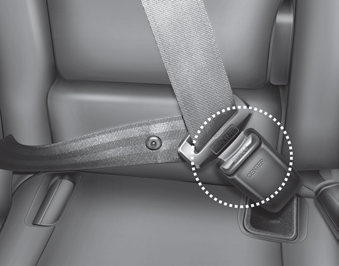
When using the rear center seat belt, the buckle with the ŌĆ£CENTERŌĆØ mark must be used.
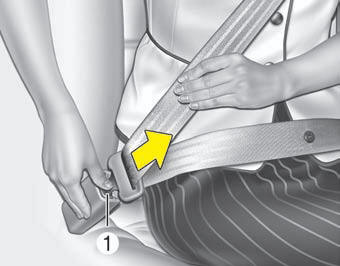
To release the seat belt
The seat belt is released by pressing the release button (1) of the locking buckle. When it is released, the belt should automatically draw back into the retractor.
If this does not happen, check the belt to be sure it is not twisted, then try again.
Shoulder belt extension guide (for 2 door)
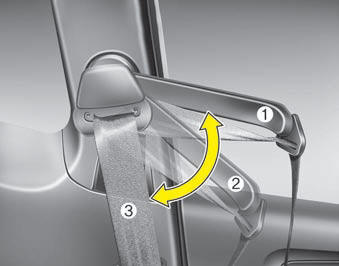
You can adjust the position of the shoulder belt extension guide for easier access to the shoulder belt.
Set the belt extension guide to the position (1~3) when using the seat belt.
Pre-tensioner seat belt
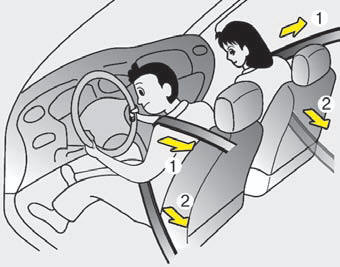
Your vehicle is equipped with driver's and front passenger's pre-tensioner seat belts.
1. Retractor pre-tensioner
The retractor pre-tensioner, which is a supplement system of the seat belts. The purpose of the retractor pre-tensioner is to tighten the shoulder belt against the occupant's upper body in certain frontal collisions.
2. Emergency Fastening Device (EFD)
The Emergency Fastening Device (EFD) is a supplemental system of the seat belts. The purpose of the EFD is to tighten the lap belt against the occupant's pelvis in certain frontal collisions.
The pre-tensioner seat belts may be activated, when a frontal collision is severe enough, together with the air bags.
When the vehicle stops suddenly, or if the occupant tries to lean forward too quickly, the seat belt retractor may lock into position. In certain frontal collisions (or side collisions), the pre-tensioner may activate and pull the seat belt into tighter contact against the occupant's body.
If the system senses excessive tension on the driver or passenger's seat belt when the pre-tensioner activates, the load limiter inside the retractor pre-tensioner will release some of the pressure on the affected seat belt.
WARNING
- Do not put anything near the buckle. Placing objects near the buckle may increase the risk of personal injury in the event of a collision.
- For your safety, be sure that the belt webbing is not loose or twisted and always sit properly on your seat.
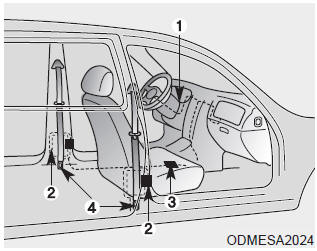
The seat belt pre-tensioner system consists mainly of the following components.
Their locations are shown in the illustration:
1. SRS air bag warning light
2. Retractor pre-tensioner assembly
3. SRS control module
4. Emergency fastening device (EFD)
WARNING
To obtain maximum benefit from a pre-tensioner seat belt:
- The seat belt must be worn correctly and adjusted to the proper position. Please read and follow all of the important information and precautions about your vehicleŌĆÖs occupant safety features ŌĆō including seat belts and air bags ŌĆō that are provided in this manual.
- Be sure you and your passengers always wear seat belts properly.
✽ NOTICE
When the pre-tensioner seat belts are activated, a loud noise may be heard and fine dust, which may appear to be smoke, may be visible in the passenger compartment. These are normal operating conditions and are not hazardous.
WARNING - Skin irritation
Wash all exposed skin areas thoroughly after an accident in which the pre-tensioner seat belts were activated. The fine dust from the pre-tensioner activation may cause skin irritation and should not be breathed for prolonged periods.
Because the sensor that activates the SRS air bag is connected with the pre-tensioner
seat belt, the SRS air bag warning light (
 )
)
on the instrument panel will illuminate for approximately 6 seconds after the ignition
switch has been turned to the ON position, and then it should turn off.
If the pre-tensioner seat belt does not work properly, this warning light will illuminate even if the SRS air bag has not malfunctioned. If the SRS air bag warning light does not illuminate when the ignition switch is turned ON, or if it remains illuminated after illuminating for approximately 6 seconds, or if it illuminates while the vehicle is being driven, please have an authorized Kia dealer inspect the pre-tensioner seat belt or SRS air bag system as soon as possible.
✽ NOTICE
Do not attempt to service or repair the pre-tensioner seat belt system in any manner. Do not attempt to inspect or replace the pre-tensioner seat belts yourself. This must be done by an authorized Kia dealer.
WARNING - Hot pre - tensioner
Do not touch the pre-tensioner seat belt assemblies for several minutes after they have been activated. When the pre-tensioner seat belt mechanism fires during a collision the pretensioner becomes hot and can burn you.
Pre-tensioners are designed to operate only one time. After activation, pre-tensioner seat belts must be replaced. If the pre-tensioner must be replaced, contact an authorized Kia dealer.
 Seat belts
Seat belts
...
 Seat belt precautions
Seat belt precautions
Infant or small child
All 50 states have child restraint laws. You should be aware of the specific
requirements in your state. Child and/or infant seats must be properly placed and
installed in the ...
See also:
Installation
Clutch cover and disc should be replaced as a set.
1.
Apply grease on a disc spline ...
Speakers Removal
Front Speaker
1.
Remove the front door trim panel and speaker connector.
(Refer to Body - "Front Door Trim")
2.
Remove the ...
General Features
ŌĆó
This audio system supports Bluetooth® hands-free and stereo-headset
features.
-
HANDS-FREE feature: Making or receiving calls wirelessly.
...
